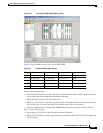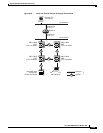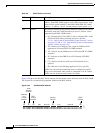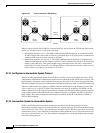
9-28
Cisco ONS 15600 Reference Manual, R7.2
Chapter 9 Management Network Connectivity
9.7.2 Link Access Protocol on the D Channel
9.7.2 Link Access Protocol on the D Channel
LAP-D is a data link protocol used in the OSI protocol stack. LAP-D is assigned when you provision an
ONS 15600 SDCC as OSI-only. Provisionable LAP-D parameters include:
•
Transfer Service—One of the following transfer services must be assigned:
–
Acknowledged Information Transfer Service (AITS)—(Default) Does not exchange data until
a logical connection between two LAP-D users is established. This service provides reliable
data transfer, flow control, and error control mechanisms.
–
Unacknowledged Information Transfer Service (UITS)—Transfers frames containing user data
with no acknowledgement. The service does not guarantee that the data presented by one user
will be delivered to another user, nor does it inform the user if the delivery attempt fails. It does
not provide any flow control or error control mechanisms.
•
Mode—LAP-D is set to either Network or User mode. This parameter sets the LAP-D frame
command/response (C/R) value, which indicates whether the frame is a command or a response.
•
Maximum transmission unit (MTU)—The LAP-D N201 parameter sets the maximum number of
octets in a LAP-D information frame. The range is 512 to 1500 octets.
Note
The MTU must be the same size for all NEs on the network.
•
Transmission Timers—The following LAP-D timers can be provisioned:
–
The T200 timer sets the timeout period for initiating retries or declaring failures.
–
The T203 timer provisions the maximum time between frame exchanges, that is, the trigger for
transmission of the LAP-D “keep-alive” Receive Ready (RR) frames.
Fixed values are assigned to the following LAP-D parameters:
•
Terminal Endpoint Identifier (TEI)—A fixed value of 0 is assigned.
•
Service Access Point Identifier (SAPI)—A fixed value of 62 is assigned.
•
N200 supervisory frame retransmissions—A fixed value of 3 is assigned.
9.7.3 OSI Connectionless Network Service
OSI connectionless network service is implemented by using the Connectionless Network Protocol
(CLNP) and Connectionless Network Service (CLNS). CLNP and CLNS are described in the ISO 8473
standard. CLNS provides network layer services to the transport layer through CLNP. CLNS does not
perform connection setup or termination because paths are determined independently for each packet
that is transmitted through a network. CLNS relies on transport layer protocols to perform error detection
and correction.
CLNP is an OSI network layer protocol that carries upper-layer data and error indications over
connectionless links. CLNP provides the interface between the CLNS and upper layers. CLNP performs
many of the same services for the transport layer as IP. The CLNP datagram is very similar to the IP
datagram. It provides mechanisms for fragmentation (data unit identification, fragment/total length, and
offset). Like IP, a checksum computed on the CLNP header verifies that the information used to process
the CLNP datagram is transmitted correctly, and a lifetime control mechanism (Time to Live) limits the
amount of time a datagram is allowed to remain in the system.


















